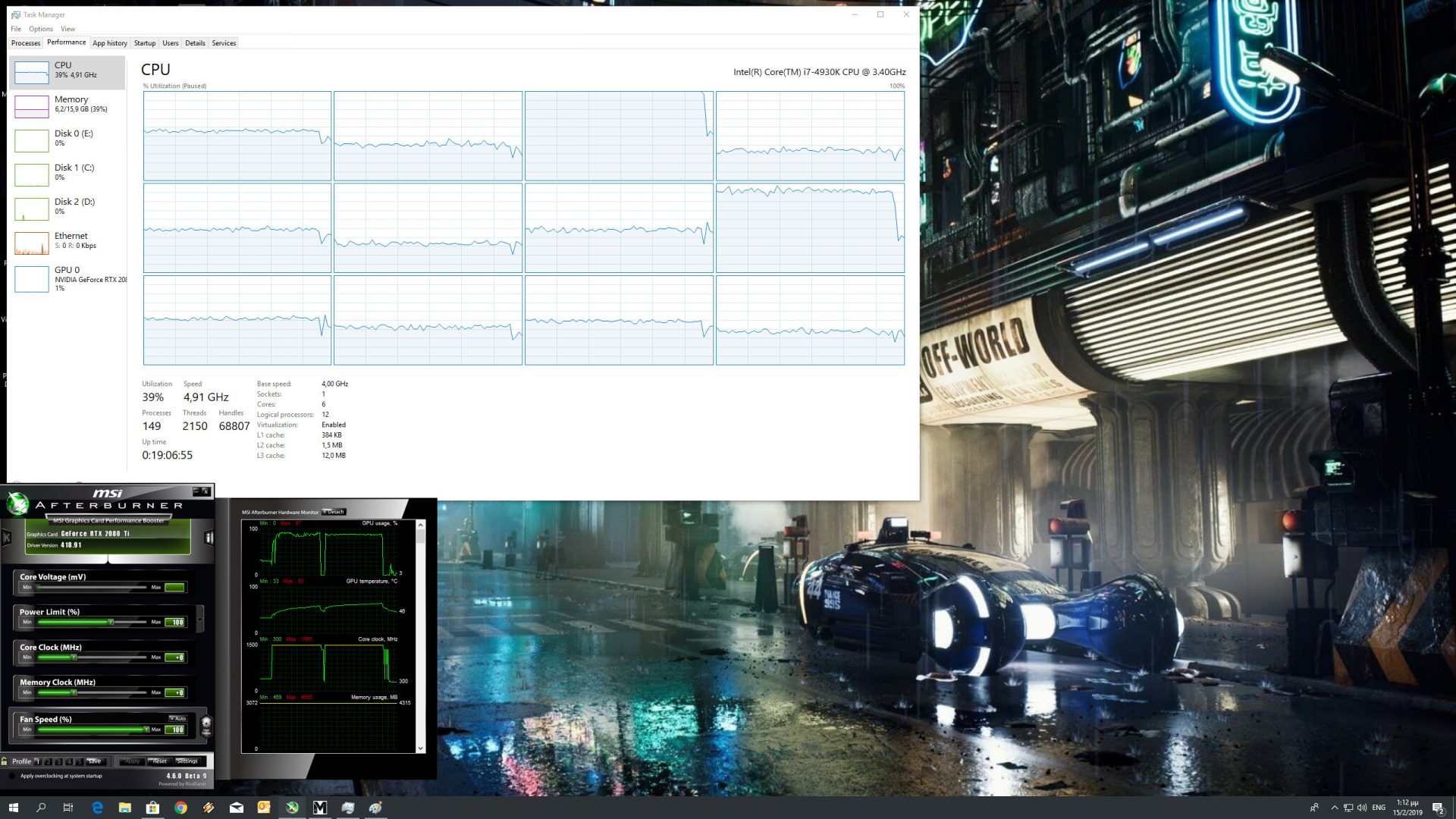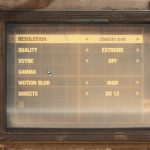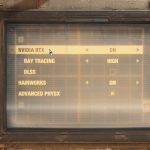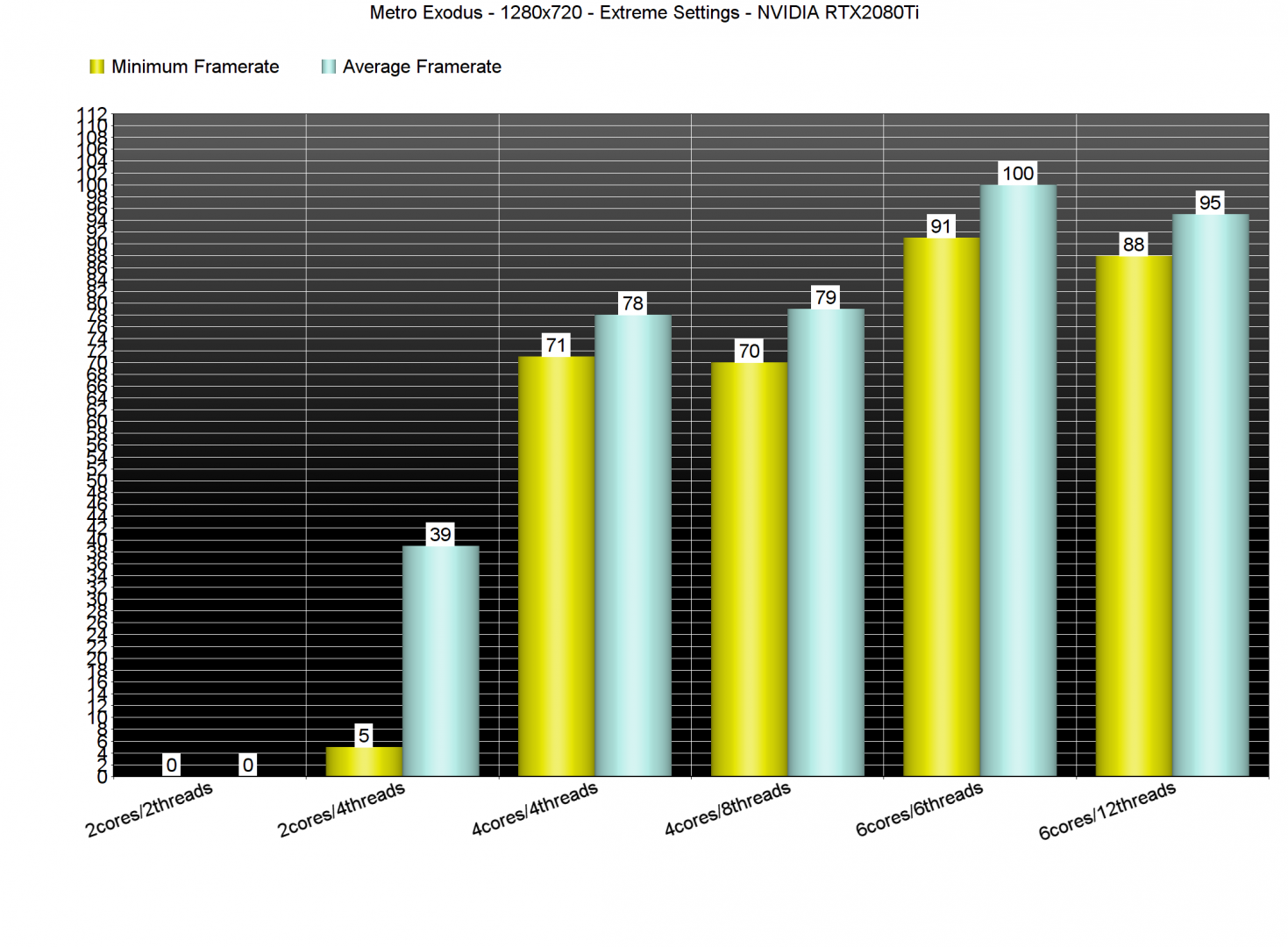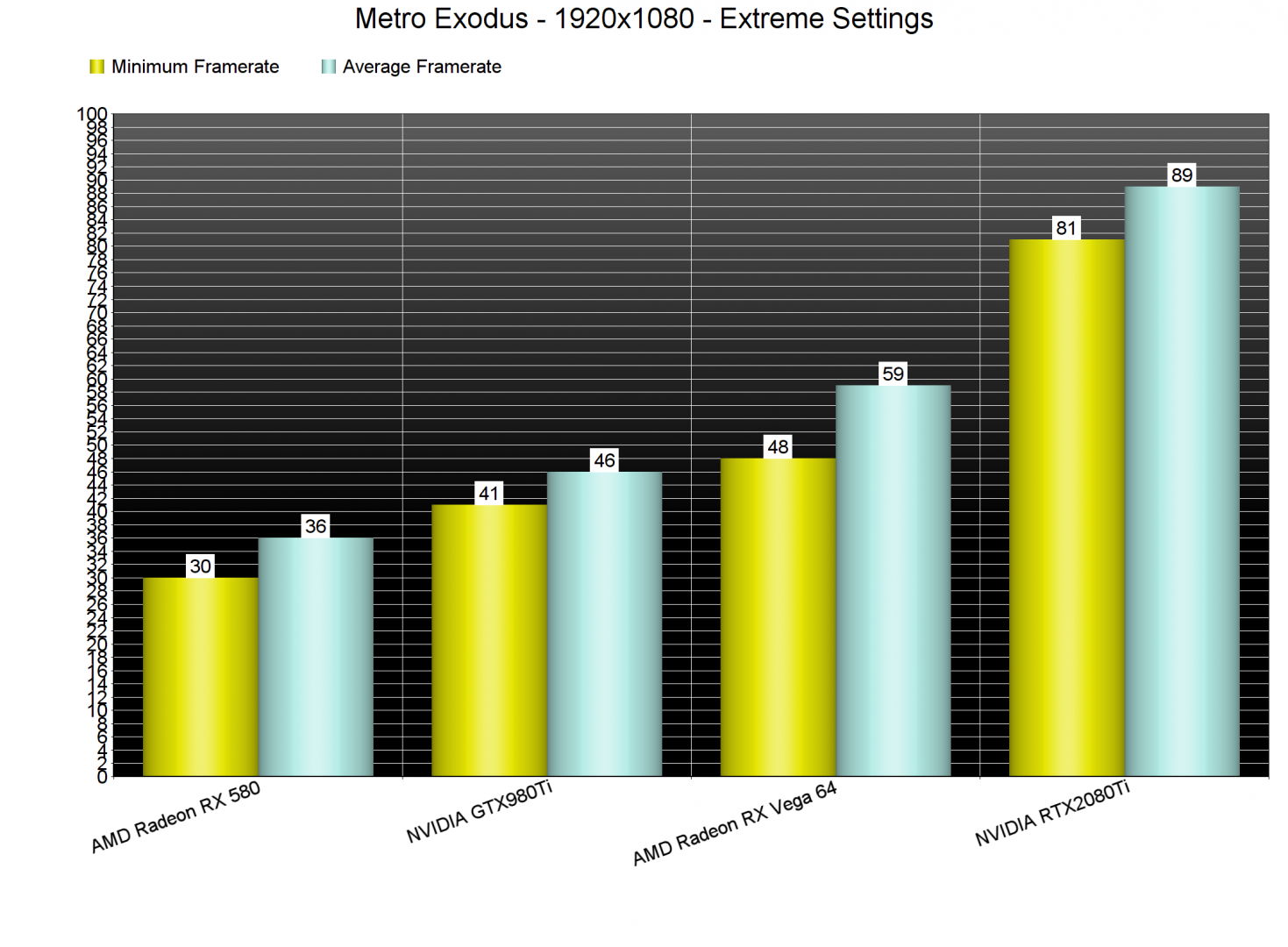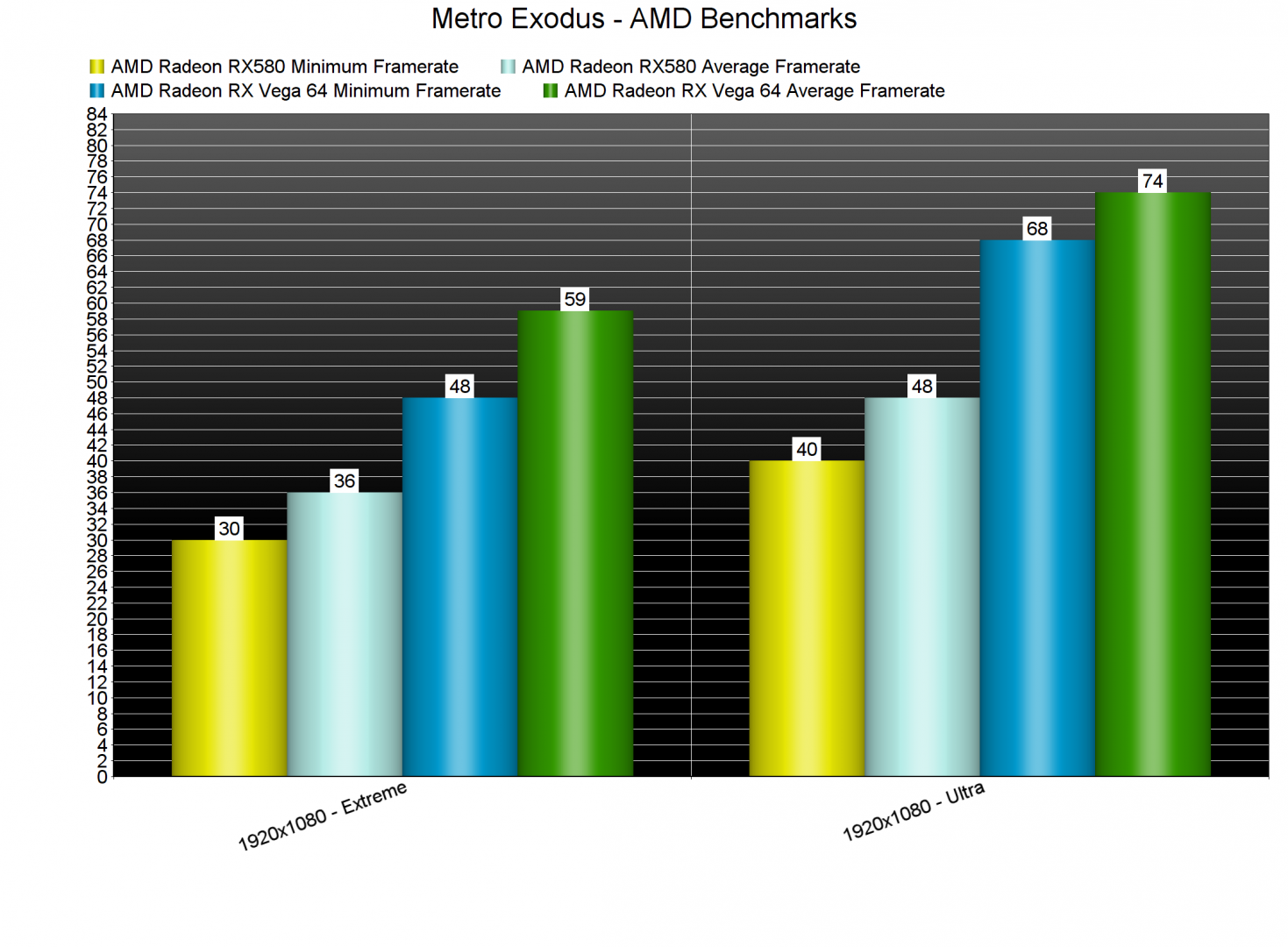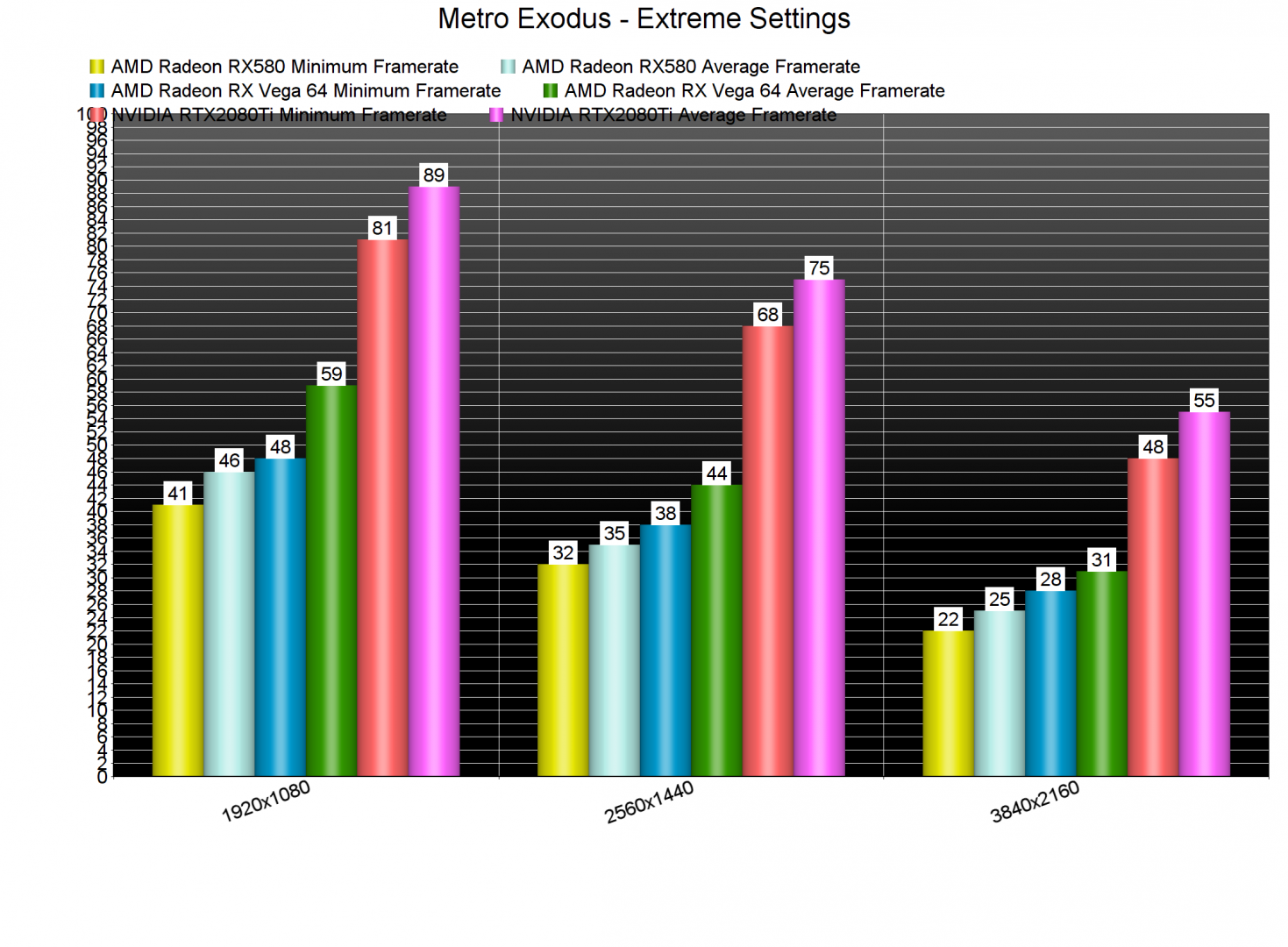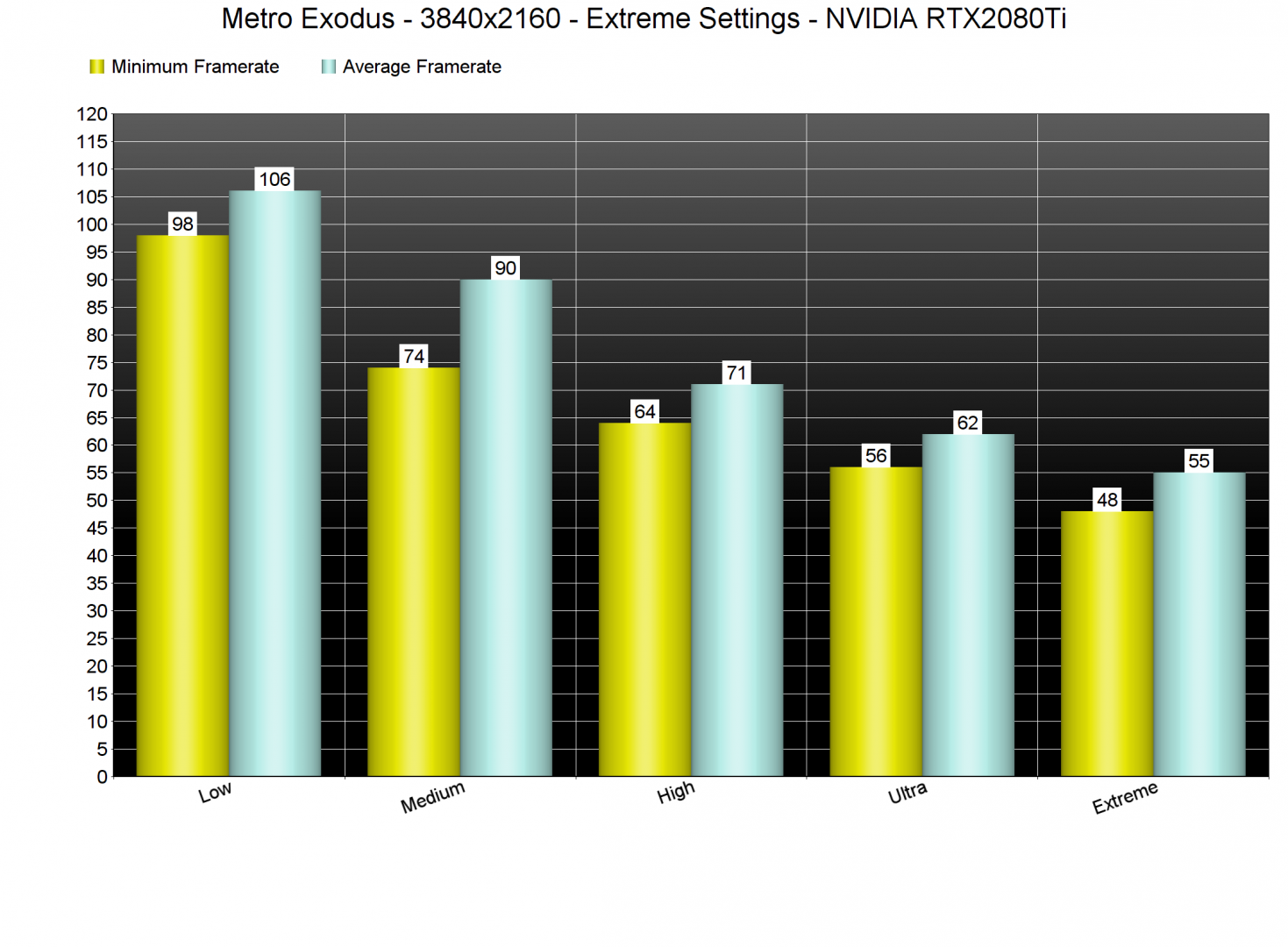Metro Exodus is a game that a lot of PC gamers have been looking forward to. These past couple of days we’ve been focusing on the game’s RTX effects but now, and after its day-1 update as well as the optimized drivers from both AMD and NVIDIA, it’s time to benchmark it and see how it performs on the PC platform.
For this PC Performance Analysis, we used an Intel i7 4930K (overclocked at 4.2Ghz) with 16GB of DDR3 RAM at 2133Mhz, AMD’s Radeon RX580 and RX Vega 64, NVIDIA’s RTX 2080Ti and GTX980Ti, Windows 10 64-bit, GeForce driver 418.91and the Radeon Software Adrenalin 2019 Edition 19.2.2. As you will see, Metro Exodus is a really demanding game so there wasn’t any reason at all to test our GTX690.
Before continuing, we want to make it crystal clear that we did not use the built-in benchmark tool. As we’ve already said, Metro Exodus’ benchmark is more like a stress test and does not represent the in-game performance. Moreover, we decided to use DX12 instead of DX11 as there wasn’t any significant difference between these two APIs.
4A Games has added very few graphics settings to tweak. PC gamers can adjust the quality of Motion Blur (you cannot complete disable it), Texture Filtering and Shading Rate (this is a resolution scaler). Naturally, PC gamers can also enable/disable Ray Tracing, DLSS, Hairworks, Advanced PhysX and Tessellation. What’s really disappointing here though is that there is only one Global/Universal option for graphics, called “Quality”. This option affects a lot of things (like for example LOD, shadows, particles and textures) and it’s really puzzling as to why 4A Games did not provide any separate graphics settings like most games do these days.
In order to find out how the game scales on multiple CPUs, we’ve simulated a dual-core and a quad-core system. For both our CPU and GPU benchmark tests we used the Caspian/desert area. This area has a huge draw distance, plants that are affected by the wind (even when not using PhysX) and can really stress both the CPU and the GPU. For our CPU tests, we’ve lowered our resolution to 1280×720 and disabled Ray Tracing, DLSS, Hairworks and Advanced PhysX. We also used the Extreme Quality setting as it comes with higher LOD settings (which obviously affect the CPU).
Unfortunately, owners of dual-core systems will experience major performance issues in Metro Exodus. Our simulated dual-core system was unable to provide an acceptable gaming experience as there were major stuttering issues even when Hyper Threading was enabled. On the other hand, our simulated quad-core system had no trouble at all running the game with constant 60fps. It’s also worth noting that Hyper Threading had a negative performance impact on our six-core system. While Hyper Threading had no effect on our simulated quad-core system, it actually reduced our overall performance on our six-core system. With Hyper Threading disabled, our i7 4930K was able to push a minimum of 91fps and an average of 100fps. When we enabled Hyper Threading, though, our minimum framerate dropped to 88fps and our average framerate dropped to 95fps.
From the above CPU benchmark tests, it becomes obvious that a modern-day quad-core system is enough for a constant 60fps experience. This basically means that most gamers will be GPU-limited as Metro Exodus requires really powerful graphics cards in order to be enjoyed.
For our GPU benchmark tests, and in order to provide an apples-to-apples comparison, we disabled Ray Tracing, DLSS, Hairworks and Advanced PhysX. On Extreme settings, both our AMD Radeon RX580 and Vega 64 were unable to offer a smooth gaming experience at 1920×1080. We’ve also experienced a bizarre GPU utilization issue on AMD’s GPUs. Our AMD Radeon RX580 was the first GPU we benchmarked and our GPU usage was around 87% at 1920×1080 on Extreme settings. Normally, this could suggest a CPU/RAM limitation, however the AMD Radeon RX Vega 64 was running the game way faster than the AMD Radeon RX580 (thus proving that we were not CPU/RAM limited in any way). Not only that, but as we’ve showcased above, our CPU was capable of pushing more than 90fps at all times (when it was not bottlenecked by the GPU). The weird thing here is that the AMD Radeon RX Vega 64 was also used at 87%. We don’t know what is happening here and whether this is something that AMD can fix via new drivers. Suffice to say that the NVIDIA graphics cards did not have this GPU utilization issue and were used to their fullest.
In case you are wondering, our AMD Radeon RX580 was able to run Metro Exodus with a minimum of 40fps and an average of 48fps at 1920×1080 on Ultra settings, and our AMD Radeon RX Vega 64 was able to offer a constant 60fps experience (68fps minimum framerate and 74fps average framerate).
The only GPU that was able to offer a smooth gaming experience at 1920×1080 on Extreme settings was the NVIDIA GeForce RTX2080Ti. NVIDIA’s most powerful gaming graphics card was also able to run the game with constant 60fps at 2560×1440.
Given the fact that Metro Exodus is a really demanding title on Extreme settings, we went ahead and tested all of the available Quality settings in 4K on our NVIDIA GeForce RTX2080Ti. This should give you an idea of how scalable the game is. And thankfully, owners of an NVIDIA GeForce RTX2080Ti can run the game in 4K on Ultra settings with 60fps. This is obviously without all the NVIDIA-specific effects, however the good news here is that the game scales great on NVIDIA’s GPUs.
Just for fun, and in order to showcase the minimal visual differences, below you can find three screenshots from our benchmark scene. Can you guess which is the High, the Ultra and the Extreme screenshots?
As we’ve already stated, Metro: Exodus is one of the most beautiful games to date, mainly due to its ray traced Global Illumination effects. Our NVIDIA GeForce RTX2080Ti was able to run the game at 2560×1440 on Extreme settings with Ray Tracing set on High and with both Hairworks and Advanced PhysX with a minimum of 55fps and an average of 65-70fps. With Ray Tracing set on Ultra, we did notice some drops to 43fps and the overall image quality was almost identical to the High setting. There are some minor visual changes but they are so subtle that you won’t really notice them while playing, which is why we strongly suggest using the High setting for Ray Tracing.
Now while Metro Exodus looks great, it still comes with some graphical shortcomings. For instance, and contrary to other modern-day titles, Metro Exodus suffers from a lot of low-resolution textures, as well as texture aligning issues on various surfaces. The facial expressions and animations of most characters are not that great, some invisible surfaces can block your firing, and there are A LOT of invisible walls throughout the game.
All in all, Metro Exodus is a really demanding PC game on Extreme settings. While the game does not require a high-end CPU, it does require a high-end GPU in order to be enjoyed. Moreover, the game underperforms on AMD’s GPUs and has some awkward GPU utilization issues. Thankfully, PC gamers can drop the Quality to Ultra (or even lower) in order to run the game in less powerful graphics cards and it’s possible to run the game with 60fps in 4K on Ultra settings on an NVIDIA GeForce RTX2080Ti. As for ray tracing, it’s possible to run the game at 2560×1440 on Extreme settings with High RT with 60fps.
The following screenshots were captured on the NVIDIA GeForce RTX2080Ti on Extreme settings with Hairworks and Advanced PhysX, Ray Tracing set on Ultra and without DLSS.
John is the founder and Editor in Chief at DSOGaming. He is a PC gaming fan and highly supports the modding and indie communities. Before creating DSOGaming, John worked on numerous gaming websites. While he is a die-hard PC gamer, his gaming roots can be found on consoles. John loved – and still does – the 16-bit consoles, and considers SNES to be one of the best consoles. Still, the PC platform won him over consoles. That was mainly due to 3DFX and its iconic dedicated 3D accelerator graphics card, Voodoo 2. John has also written a higher degree thesis on the “The Evolution of PC graphics cards.”
Contact: Email


